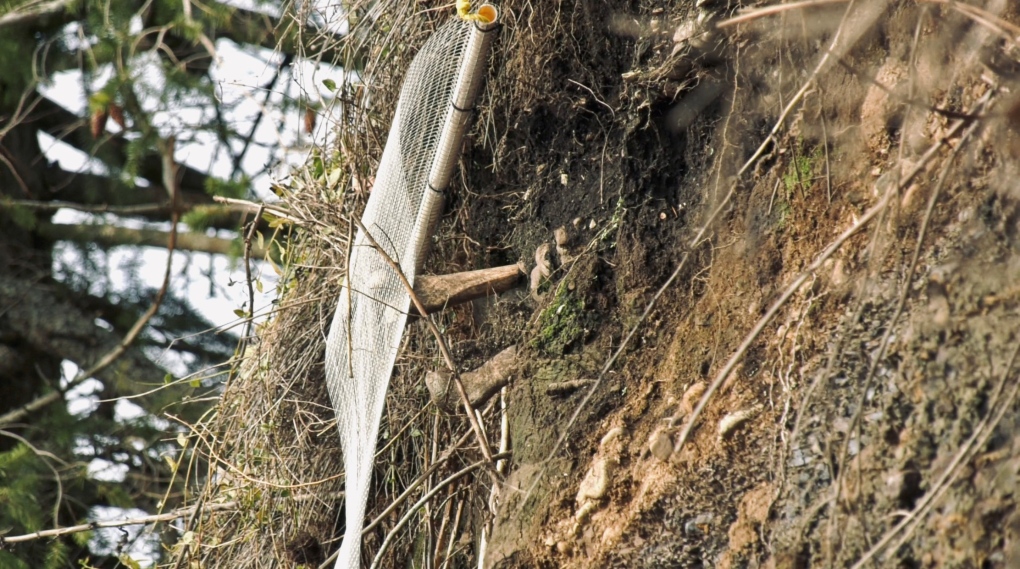Coastal erosion is unearthing ancestral bones on this B.C. Gulf Island
A walk past a cemetery can conjure many emotions – sadness, fear and finality. But rarely does it conjure the idea of actually seeing a deceased loved one again.
On British Columbia's Gabriola Island, however, coastal erosion is unearthing more than just memories.
"I come here and I go, 'What am I going to do about this?' says Jared Hooper, chair of the Gabriola Cemetery Commission.
The cemetery sits atop of a 10-metre cliff on South Road and faces Mudge Island to the west. The land was donated in 1882 by Magnus Edgar, an early settler who is also buried there along with his family.
"It’s a lovely peaceful cemetery,” he says. "Except for the problems we are having with bank slipping away."
Hooper's job is to watch over the island's only cemetery – a cemetery that's slowly sliding off a cliff and into the ocean.
"You can't stop it," he says. "You might as well let nature take its course."
Some of the island's earliest pioneers are buried on the bluff, with graves dating back to 1882.
Approximately 15 of those settlers are buried on what's called a midden, a refuse dump for domestic waste that was used by Snuneymuxw inhabitants centuries ago.
“That midden is full of broken clam shells and artifacts,” Hooper adds.
Geologists have told the cemetery that the lower area of the cemetery near the water is much softer because of the midden.
"It’s sliding seaward over harder layers lower down that go right down to the beach," says Hooper.
With the bank eroding by about 20 to 25 centimetres per year, and the caskets long since decomposed, the problem calls for some out-of-the-box thinking.
"I've got that wire basket hanging over the edge so they don't just fall down to the beach," Hooper says. "You can throw a million dollars at it and it’ll fall down in a number of years."
 Leg bones exposed on a bluff on Gabriola Island, B.C. (CTV News)
Leg bones exposed on a bluff on Gabriola Island, B.C. (CTV News)
He's slowly collecting the bones until full skeletons can be relocated up the hill and these unsettled settlers can settle once again.
"These bones, they are going to be coming out of the bank for who knows, 20, 30, 40 more years?"
Hooper has connected with some of the living relatives of the settlers buried on the island and they are OK with relocating the remains once the time comes, he says.
For those plotting their own burials on the island, there's still plenty of room in the back, Hooper says.
"We've got lots of room left for cremations – maybe 100 spots or more."
CTVNews.ca Top Stories

Budget 2024 prioritizes housing while taxing highest earners, deficit projected at $39.8B
In an effort to level the playing field for young people, in the 2024 federal budget, the government is targeting Canada's highest earners with new taxes in order to help offset billions in new spending to enhance the country's housing supply and social supports.
BUDGET 2024 Feds cutting 5,000 public service jobs, looking to turn underused buildings into housing
Five thousand public service jobs will be cut over the next four years, while underused federal office buildings, Canada Post properties and the National Defence Medical Centre in Ottawa could be turned into new housing units, as the federal government looks to find billions of dollars in savings and boost the country's housing portfolio.
Some of the winners and losers in the 2024 federal budget
With a variety of fiscal and policy measures announced in the federal budget, winners include small businesses and fintech companies while losers include the tobacco industry and Canadian pension funds.
From housing initiatives to a disability benefit, how the federal budget impacts you
From plans to boost new housing stock, encourage small businesses, and increase taxes on Canada’s top-earners, CTVNews.ca has sifted through the 416-page budget to find out what will make the biggest difference to your pocketbook.
Police to announce arrests in Toronto Pearson airport gold heist
Police say that arrests have been made in connection with a $20-million gold heist at Toronto Pearson International Airport one year ago.
Teen hockey players arrested for sexual assault following hazing incident: Manitoba RCMP
Three teenagers were arrested in connection with a pair of alleged hazing incidents on a Manitoba hockey team, police say.
'I Google': Why phonebooks are becoming obsolete
Phonebooks have been in circulation since the 19th century. These days, in this high-tech digital world, if someone needs a phone number, 'I Google,' said Bridgewater, N.S., resident Wayne Desouza.
Liberals aim to hit the brakes on car theft with new criminal offences
The Liberals are proposing new charges for the use of violence while stealing a vehicle and for links to organized crime, as well as laundering money for the benefit of a criminal organization.
BUDGET 2024 Ottawa police get $50 million to boost security around Parliamentary Precinct
The Ottawa Police Service will receive $50 million in new federal funding over the next five years to "enhance security" around the Parliamentary Precinct.































